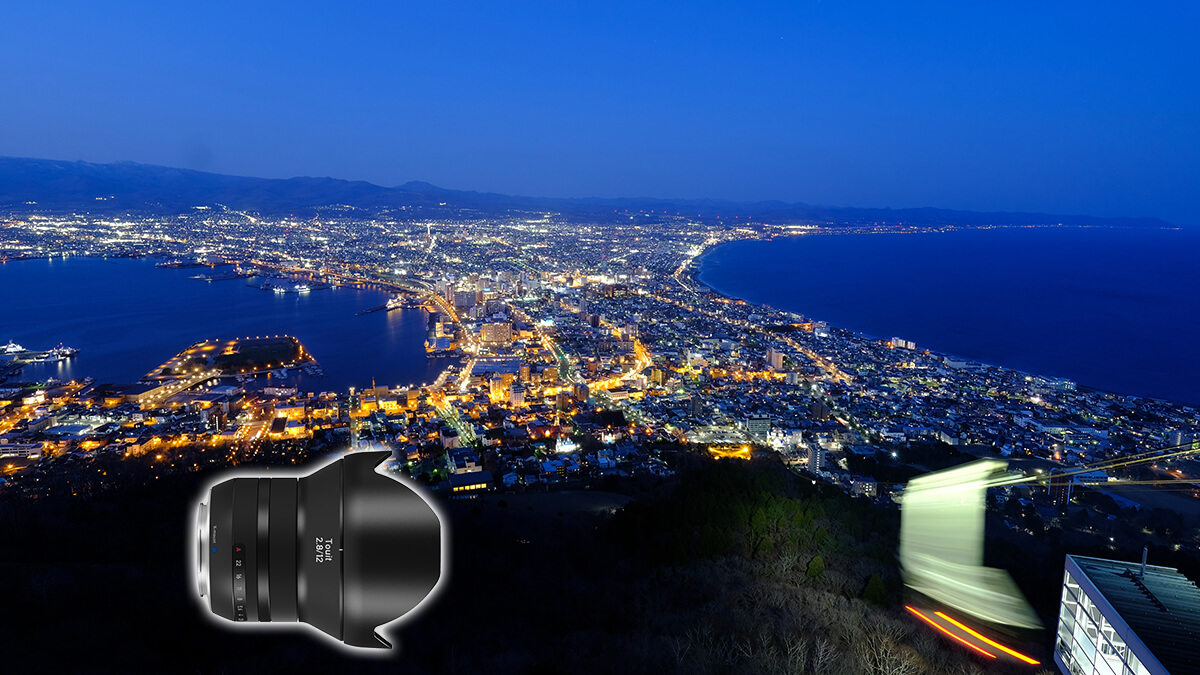
[Actually, you can enjoy it for free! 】The spectacular view from Mt. Hakodate, which even locals who went to "ZEISS Touit 2.8/12" is delicious twice.
This is a slightly unusual author, and when you try out new lenses, you'll want to take a chart. This author had the opportunity to try out Zeiss' wide-angle prime focus, the ZEISS Touit 2.8/12. The night view of Mt. Hakodate was just a free period that even locals don't know about, so I went out to take a photo, so I'd like to introduce you to the situation.
table of contents
- What is Zeiss' "ZEISS Touit 2.8/12"?
- Night view of Mt. Hakodate
- What period is the period when you can enjoy the night view of Mt. Hakodate in the Michelin Guide ★★★ for free?
- Even in April, it can be so cold that the puddles on the summit freeze.
- We prepare a tripod to take a picture of the time when the blue sky remains and the city lights brighten up well.
- "ZEISS Touit 2.8/12" has a high resolution since the aperture is open, and the peak resolution is around F5.6
- Hakodate Mountain's morning glow
- Summary: Enjoy the spectacular view from Mt. Hakodate for free night views and morning glow times
- Details and purchase of "ZEISS Touit 2.8/12"
What is Zeiss' "ZEISS Touit 2.8/12"?
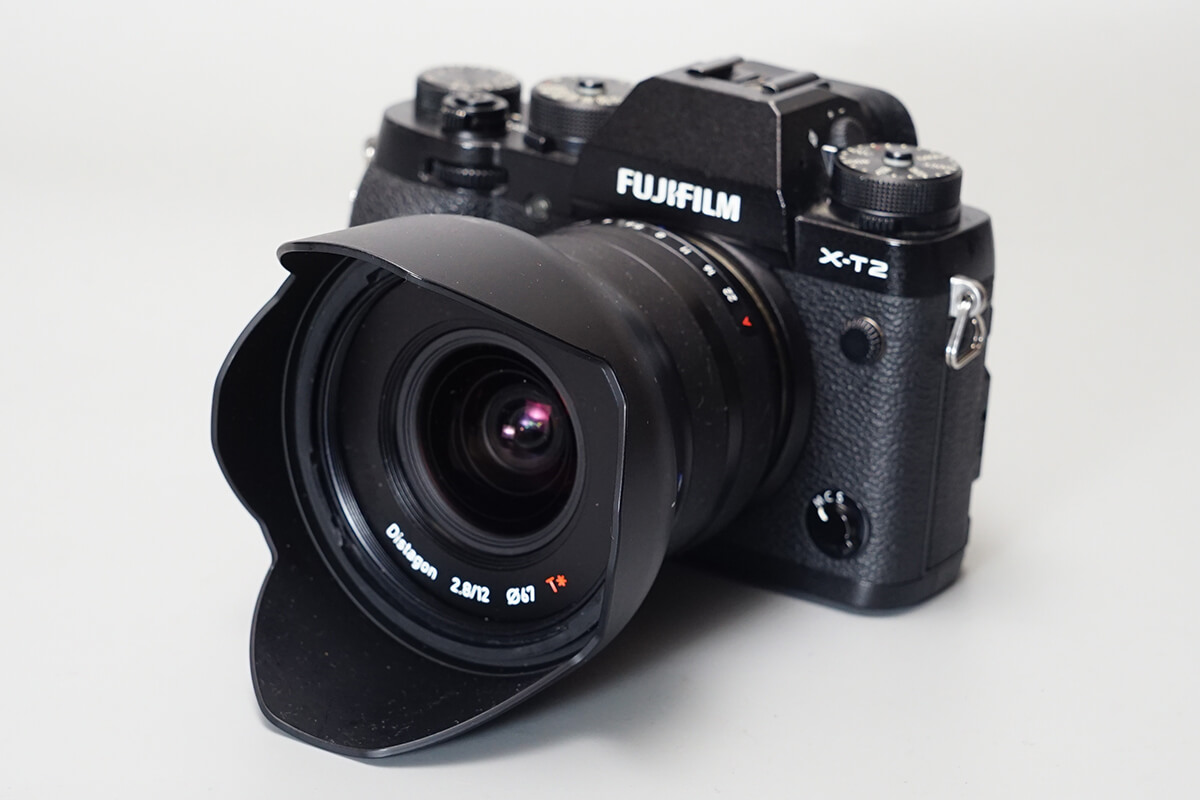
The "ZEISS Touit 2.8/12" is attached to the X-T2 of the FUJIFILM X-mount. It is compact and has a good balance with the body, making it a lens that you'll want to take anywhere.
Wide-angle single-focal lens from the Zeiss Touit series is also available for FUJIFILM X-mount
I am actually a liberal arts camera lens otaku, as I was originally an editor for a monthly camera magazine. He has also written many articles on camera and lenses on camera sites and gadget sites, but his love for lenses has grown so he has published e-books on Amazon Kindle, such as "Lens Database" and "Lens Lab," which include shooting results from original lens analysis charts, along with his lens review master Koyama Yoshiji.
I started taking lens charts because I didn't really understand the criteria for evaluation in many lens reviews, such as resolution and beauty of blur. I wanted to understand the differences in lens depictions, but since I didn't have any guidelines to use as a standard, I created the current evaluation axis with Koyama Yoshiji, based on a live-action chart.
In fact, Batis and Loxia, which are currently available as ZEISS lenses in Japan, have already been published as Lens Lab series after completing chart analysis. However, the "Touit" series, which is available for the FUJIFILM X-mount and Sony E-mount for APS-C machines, has not had the opportunity to test, and we have not been able to analyze charts, but now we have finally got the opportunity to test it, so we will try out the "ZEISS Touit 2.8/12", "ZEISS Touit 1.8/32", and "ZEISS Touit 2.8/50M" in various outdoor scenes, and we will share the results with you.
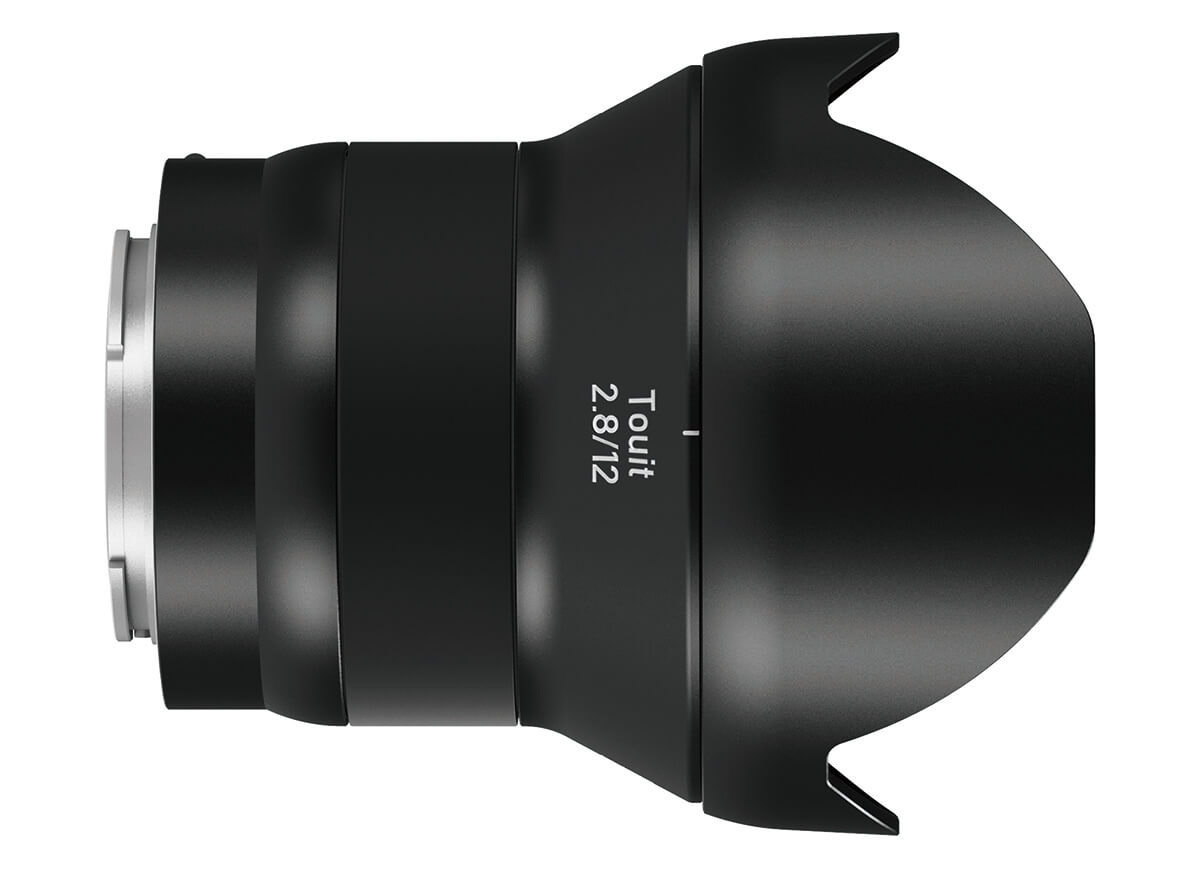
This is a bit of a bit of a bit of a bit of a bit of a bit more, but as shown in the photo above, the ZEISS Touit 2.8/12 for Sony E-mounts does not have an aperture ring.
This time, we will be the first wide-angle prime lens, the ZEISS Touit 2.8/12. Zeiss, which currently handles the ZEISS brand, is one of the two legendary major companies in the lens optics industry. In the camera lens industry, Zeiss and Leica can be considered separate categories, and can be said to be the brands we've always admired. Its status is also unshakable as an ultra-luxury binoculars brand in the outdoor industry.
ZEISS Touit 2.8/12 is a wide-angle prime lens for APS-C mirrorless single-lens cameras. The actual price is around 120,000 yen. As mentioned above, there are two available for FUJIFILM X-mount and Sony E-mount. The lens has a focal length of 12mm, but since it is attached to an APS-C machine, the actual angle of view is equivalent to 18mm. The brightness of the lens is F2.8.
The ZEISS Touit 2.8/12, which has 8 groups and 11 lenses, has a maximum diameter of approximately 82mm and a total length of 81mm (including cap), weighs 260g for the Sony E and 270g for the FUJIFILM X, making it lightweight and compact. Additionally, the design of the lens hood integrated into the lens will give you a beautiful joy in owning it.
The "ZEISS Touit 2.8/12" has a shortest shooting distance of about 18cm, and the number of aperture blades that have a major impact on the shape of the blur is 10, which is rare for a wide-angle lens, making it a luxurious design. With this "ZEISS Touit 2.8/12," I headed to take a photo of the night view of Mt. Hakodate, one of Hokkaido's most famous tourist destinations.
Recommended points
- Delicate and detailed depictions typical of Zeiss
- Lightweight and compact, beautiful design that satisfies your desire to own
- Beautiful blurring due to 10 blades, which is rare for wide-angle lenses.
- Few aberrations such as on-axis chromatic aberration, magnification chromatic aberration, distortion, etc.
- T* coating that is strong in flares and ghosts
Points that interest me
- Prices that seem expensive for numerical specs
Main Specifications and ratings
| item | ZEISS Touit 2.8/12 |
|---|---|
| Focal distance | 12mm |
| Aperture range | F2.8-F22 |
| Lens composition | 8 groups 11 pieces |
| Minimum shooting distance | 0.18m |
| Angle of view (diagonal/horizontal/vertical) | 99° / 39° / 66° |
| Shooting magnification | 1:7.2 |
| Face wings | 10 sheets |
| Filter diameter | 67mm |
| Maximum diameter | 82mm |
| full length | Sony E: 81mm/FUJIFILM X: 86mm (both include caps) |
| weight | Sony E: 260g/FUJIFILM X: 270g |
| design | ★★★★☆ |
| Resolution | ★★★★☆ |
| Portability | ★★★★☆ |
| The beauty of the blur | ★★★★☆ |
| Less aberration | ★★★★☆ |
| Cost Performance | ★★★☆☆ |
Night view of Mt. Hakodate
What period is the period when you can enjoy the night view of Mt. Hakodate in the Michelin Guide ★★★ for free?
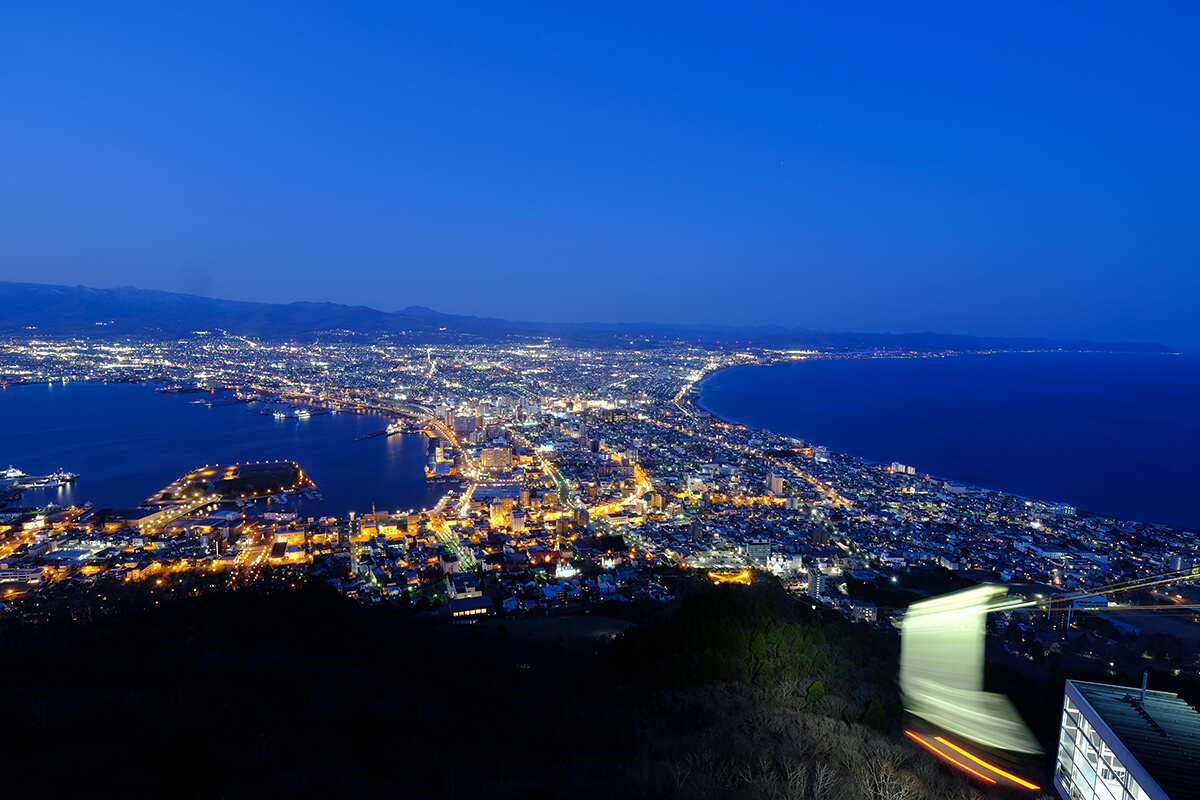
ZEISS Touit 2.8/12 / FUJIFILM X-T2 / Equivalent to 18mm / Aperture priority AE (F5.6, 5 seconds) / ISO 200 / Exposure compensation: +0.67EV / WB: Sunny / Film Simulation: Velvia / Tripod: SLIK Light Carbon E84 II Mt. Hakodate is a world-famous night view spot. The blue of the sky remains, and the time period when the city lights are lit up is very short. I want to capture this timing and take a picture.
Mount Hakodate is famous as a tourist destination in Hokkaido and as a famous spot for Japan's night views. The night view of Mt. Hakodate is a Michelin guide that can be said to be the finest three stars. However, during times when the night view is most beautiful, you cannot climb to the summit by your own car or rental car, so you will generally have to take a ropeway, bus or taxi, which means you will be able to enjoy the viewing night view for a fee.
Furthermore, from November, when the trails are closed due to snow, the ropeways are generally only available from the beginning of April. This ropeway costs 1,800 yen round trip for adults (junior high school students and above) and 900 yen round trip for children. Therefore, it costs about 6,300 yen to travel between two couples and families of junior high school students.
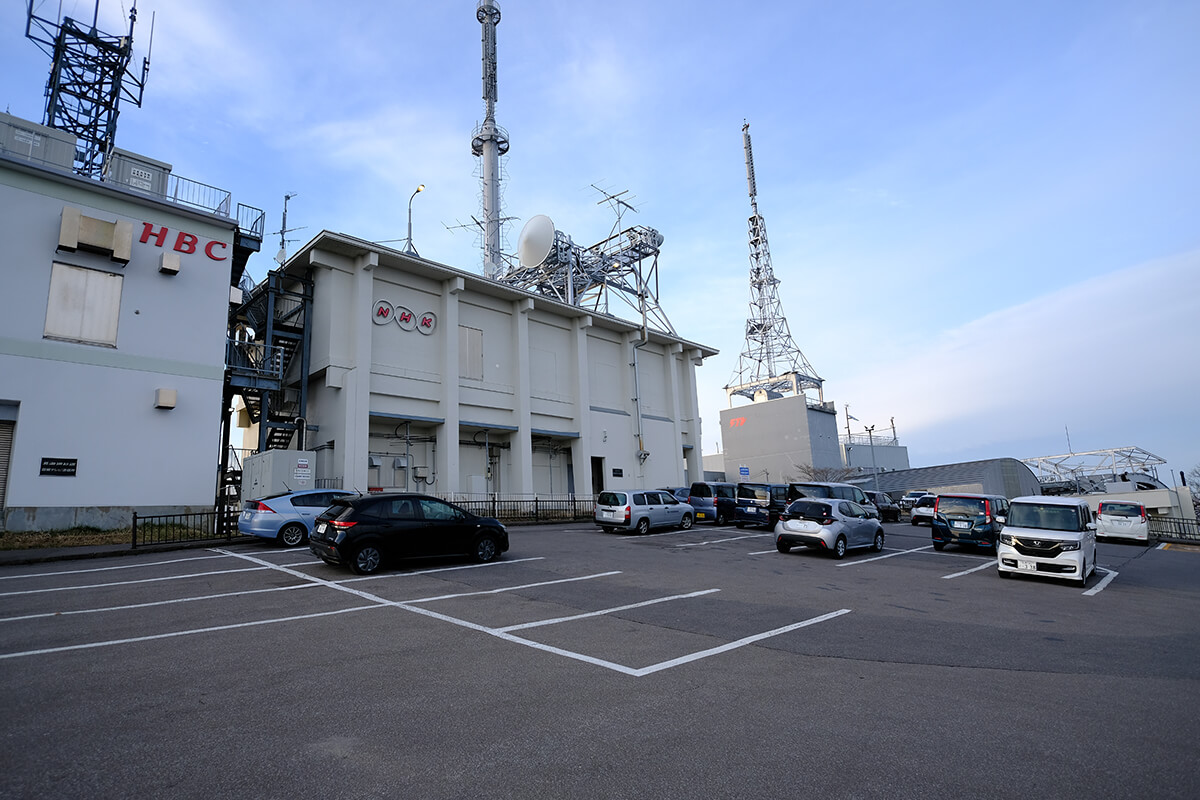
A parking space for general cars located on the summit of Mt. Hakodate. There isn't much space available so I'd like to arrive early.
It's probably a great deal if it's only once for sightseeing, but for someone like me who visits Mt. Hakodate many times a year to photograph, it's a bit expensive. If you're not good at it, you can climb two days in a row like this one, so it's recommended for those people for about 10 days from the beginning of April to mid-April.
Even if the snow on the trail melts, there will be traffic restrictions for your own cars and rental cars during the hours when the night views are best seen from late April to September, from 5pm to 10pm, and from October to mid-November, there will be traffic restrictions for your own cars and rental cars for about 10 days from early to mid-April. For details, you can search for " Hakodate City Official Tourist Site Hakobura " for details, such as "Hakodate Mountain Traffic Restrictions" and other information. In 2024, 11 days from April 8th to April 18th were periods without traffic restrictions.
Even in April, it can be so cold that the puddles on the summit freeze.

ZEISS Touit 2.8/12 / FUJIFILM X-T2 / Equivalent to 18mm / Aperture priority AE (F5.6, 1.2 seconds) / ISO 200 / Exposure compensation: +0.67EV / WB: Sunny / Film Simulation: Velvia / Tripod: SLIK Light Carbon E84 II
This is a photo that was shuttered for a test approximately 10 minutes before the photo posted earlier. The shooting settings are almost the same, so the impression of the photo will be completely different, just by only 10 minutes of shooting time.
In 2024, for two days on April 9th and April 10th, I headed to the observation deck at the summit with ZEISS Touit 2.8/12 to photograph the night view of Mt. Hakodate, where traffic restrictions on my own cars and rental cars were lifted. There are two points to note when doing this.
One reason is that the summit of Mt. Hakodate in April is as cold as midwinter, depending on the weather.
Another thing is to "preserve parking before sunset if you want to avoid crowds."
Many people seem to be savouring the cold of Hakodate in April, when the snow has melted, and surprisingly, they are wearing light clothing and waiting for the night view. However, on April 9th, when I actually visited Mt. Hakodate, the ropeway stopped due to strong winds. The temperature during the night view period was 2.2 degrees, but after taking a photo of the sunrise the next day, the puddles near the summit that I found were firmly frozen. Strong winds at windswept peaks and temperatures that can fall below zero even in April require equipment similar to midwinter.
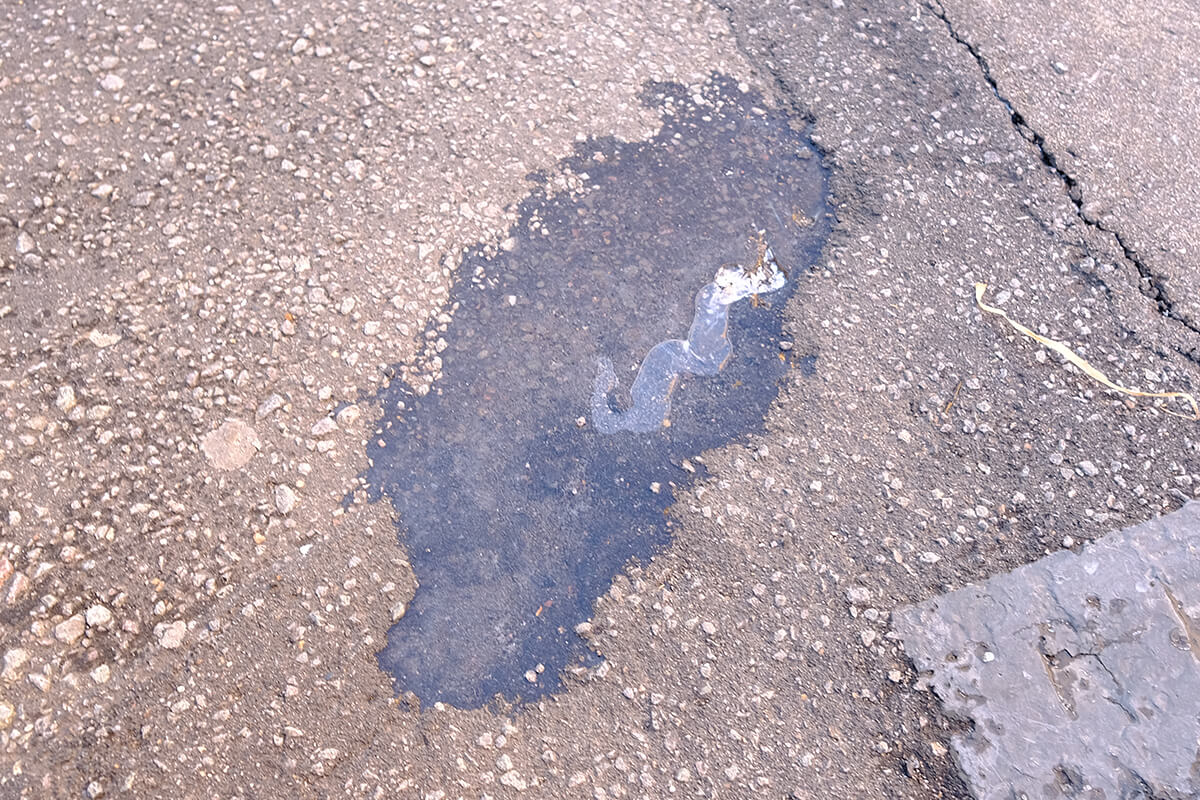
Even though it was April 10th, when I finished filming during the morning sun, the puddles at the summit of Mt. Hakodate were frozen as shown in the photo. You should think it's this cold.
I had expected it to be quite cold, so I wore a long winter down coat over a thin down jacket, but it was still so cold that my hands with thin gloves would sniff. The tourists in spring outfits were really shaking. If you're looking for the night view of Mt. Hakodate, we recommend using solid winter gear.
Also, if it's this cold, you might want to keep your time at the summit as short as possible, but we recommend arriving at the observation deck at the summit before sunset to secure a parking space. Basically, during the night view hours, there are traffic restrictions on your own cars and rental cars all year round, so there is not much parking space. Therefore, it is possible that there is no parking space if you arrive at the summit at the peak of the night view.
We recommend that you prepare solid winter clothes and arrive at the summit early.
We prepare a tripod to take a picture of the time when the blue sky remains and the city lights brighten up well.
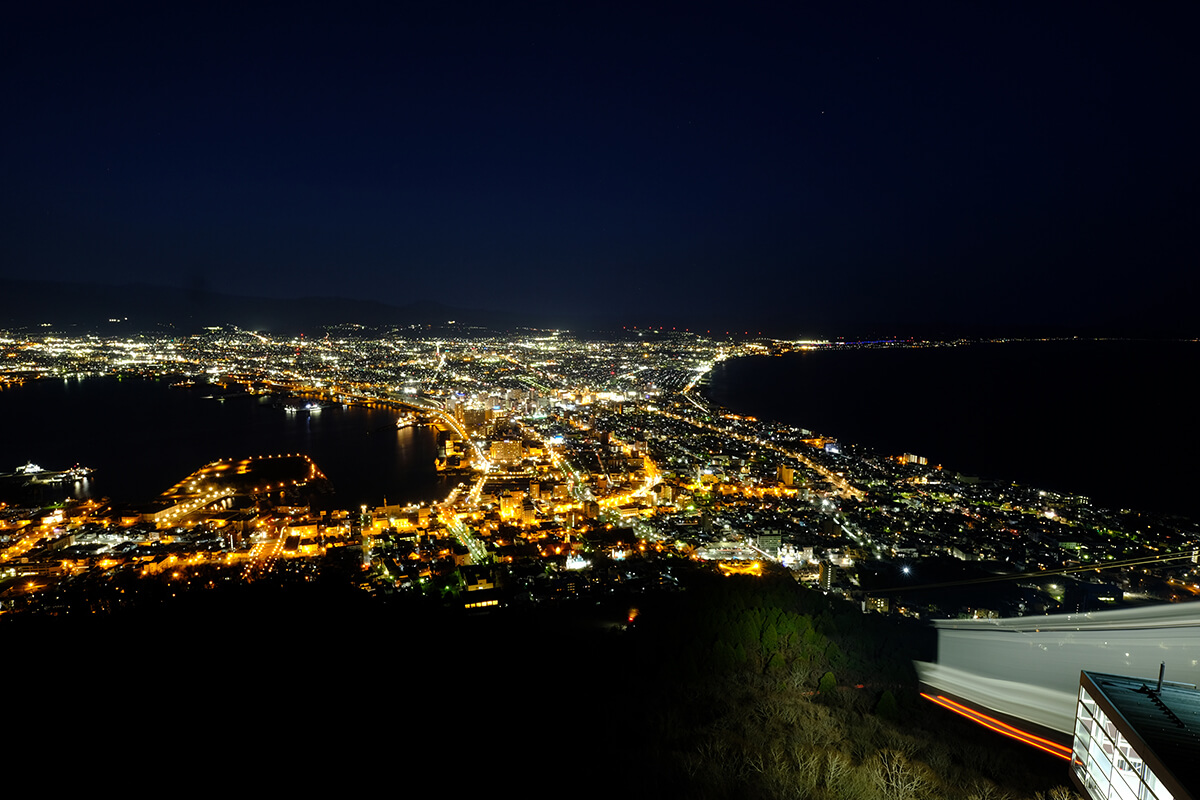
ZEISS Touit 2.8/12 / FUJIFILM X-T2 / Equivalent to 18mm / Aperture priority AE (F8.0, 14 seconds) / ISO 200 / Exposure compensation: +0.67EV / WB: Sunny / Film Simulation: Velvia / Tripod: SLIK Light Carbon E84 II
I may not believe you, but this is a picture taken about 15 minutes after taking a picture of the night view I first posted. Unfortunately, you can see that the blue of the sky is gone.
In the early April season when I visited Mt. Hakodate, the sunset usually goes down around 6:10pm, and from there it gradually gets darker, lights are on to town houses and buildings, and the best time to take pictures of night views, with the bright and blue sky still remaining from around 7pm. Naturally, it varies depending on the season and weather, so I set the camera on a tripod and wait for this moment from the sunset time, taking pictures. By the way, I changed the tripod to SLIK's new "SLIK Light Carbon E84 II" starting this season, so I was looking forward to using it.

Even when the ropeway is stopped due to strong winds, many tourists are on the Hakodate Mountain summit observation deck during the night view period. The photo is quite empty.
To put it simply, the shooting settings are Aperture Priority AE, and the aperture is ZEISS Touit 2.8/12, F2.8 is the brightest open F2.8 or F5.6, which increases the overall screen resolution. The white balance is sunny and the color mode is vivid. In the FUJIFILM X-T2 I used this time, I would like to use the Velvia for film simulation, and I would like to take a photograph of the basic ISO sensitivity of 200, changing the exposure compensation from -1.0EV to +1.0EV. Of course, a tripod is essential when shooting night views with low ISO sensitivity. The author uses a sturdy tripod with a pipe diameter of 28mm, such as the "SLIK Light Carbon E84 II."
If possible, I would like to take photos with a low sensitivity of ISO 200, which is less noise, but the summit of Mt. Hakodate has many windy days, and if the shutter speed is slow with low ISO sensitivity, there is a risk of blurring even when using a tripod, so we recommend that you change the ISO sensitivity and take photos with a faster shutter speed setting.
"ZEISS Touit 2.8/12" has a high resolution since the aperture is open, and the peak resolution is around F5.6

Photographed results for the resolution chart for "ZEISS Touit 2.8/12". The standard chart is between 1 and 1.1. The center part has a fairly detailed resolution, starting with an open aperture of F2.8.
If I had the chance to try out a new lens, in addition to the resolution charts shown above, I also take a live-action chart of a bobby disc, ambient light drop, the shortest shooting distance (macro), on-axis chromatic aberration, and for wide-angle lenses, I will check the basic performance of the Sagittal Coma Flare. We have published a data collection compiled of these in the e-book "Lens Database" series, and for the "ZEISS Touit 2.8/12" that we took to Mt. Hakodate this time , we have reproduced some of the data compiled in this article as the ZEISS Touit 2.8/12 Lens Database
I had finished these tests before taking pictures of the night views at Mt. Hakodate, so if I was going to take a picture with the "ZEISS Touit 2.8/12," I decided to take a picture with either F5.6, which has the highest resolution on the entire screen, or F2.8, which has the highest resolution while ensuring sufficient brightness. The "ZEISS Touit 2.8/12" tends to decrease resolution due to relatively excessive aperture, and diffraction and small aperture blur tend to occur at small F values, so we decided that there is no need to narrow it down to F8.0, which is often said to be the peak resolution for ordinary lenses (which is often not the case in reality).

The peak resolution of the entire screen for "ZEISS Touit 2.8/12" is F5.6 to F8.0. The resolution begins to decrease around F11, so I prefer F5.6.
We have also posted the results of the resolution charts taken at F5.6, F8.0, and F11, which are the peaks of resolution, but F11 clearly shows a tendency to decrease due to excessive aperture, so it can be determined that a narrower aperture to "ZEISS Touit 2.8/12" is sufficient to narrow it down to around F5.6.
Incidentally, in the ZEISS Touit 2.8/12, near the opening of F2.8, the center part has a delicate depiction, yet is meticulous and sharp, while the surrounding part has a delicate resolution, giving it a slightly weaker contrast. As this is narrowed down, the surrounding area tends to change to a delicate, detailed, and high contrast, and I believe F5.6 to F8.0 is the peak resolution of the entire screen. The F11 tends to have a slight reduction in resolution due to a slight over-thinning, so personally I prefer F5.6 over F8.0.
This resolution chart also observes the amount of distortion and the occurrence of chromatic aberration due to the overall distortion, but the "ZEISS Touit 2.8/12" has fewer aberrations, making it a real Zeiss experience.
Hakodate Mountain's morning glow
Free if it's a morning glow! It is also recommended to visit by car the day after seeing the night view.
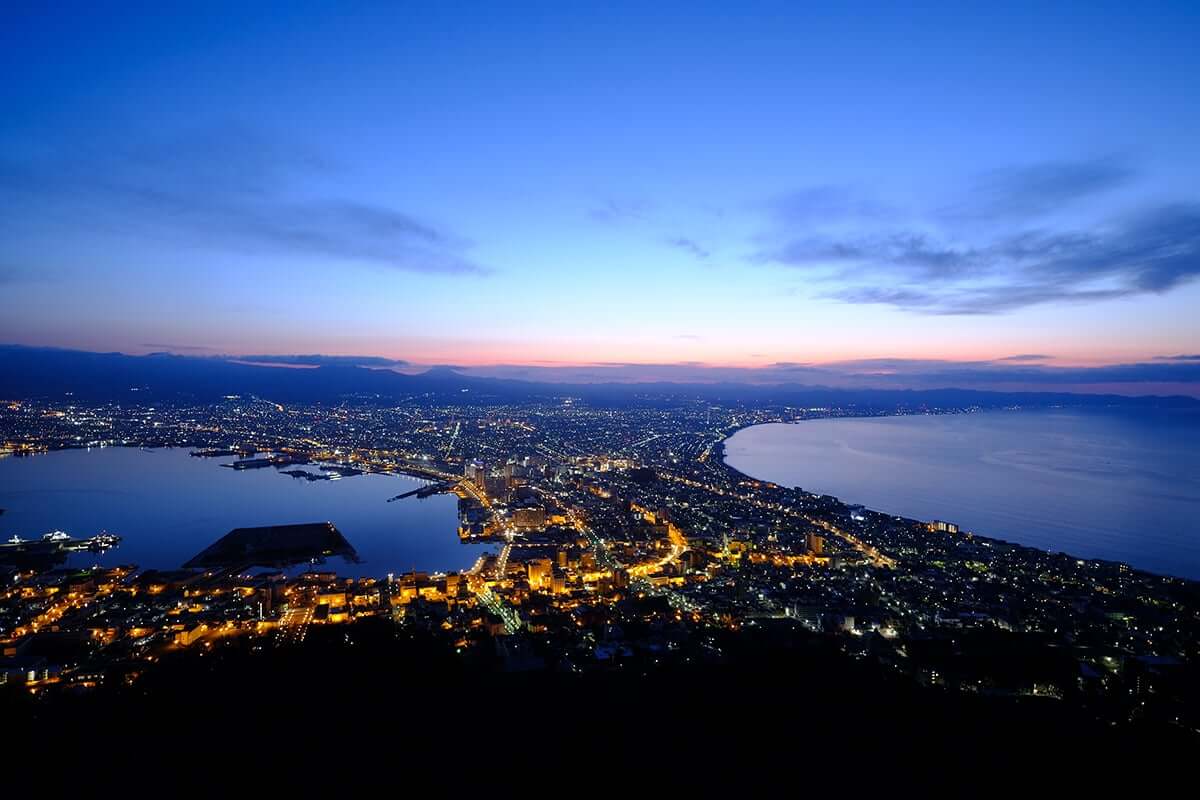
ZEISS Touit 2.8/12 / FUJIFILM X-T2 / Equivalent to 18mm / Aperture priority AE (F2.8, 1.2 seconds) / ISO 200 / Exposure compensation: +1.0EV / WB: Sunny / Film Simulation: Velvia / Tripod: SLIK Light Carbon E84 II
A photo taken just before dawn. It's a shame that the city lights are lonely compared to the peak hours of the night view, but the beautiful red color of the morning glow in the sky in the background is what I like, which is what I like.
The free view of Mt. Hakodate is available for free on your own or rental cars, and the 2024 free period ends on April 18th. So, what should you do if you want to go see the spectacular views of Mt. Hakodate? I think there are also questions like this.
If you are visiting Hakodate for a while, you should definitely take a look at the beautiful night view after sunset, so you should definitely take a ropeway or bus, but for the author, who frequently visits Hakodate, climbs to the summit of Mt. Hakodate by car or rental car, aiming for the morning glow. The photos shown above are not actually night views, but before dawn.
Traffic restrictions on Mt. Hakodate are intended to avoid crowds during night view times, so there are no traffic restrictions during the day, midnight or early morning, from 5pm to 10pm from late April to September, and from 4pm to mid-November. Please note that the trail will be closed from late November to early April due to snow.
The night view from Mt. Hakodate is a view of the city stretching northeast from the summit. Therefore, the sunset sets in the opposite direction from the direction of viewing the night view, but the sun sets from behind Hakodate city center, although there are changes in seasons. In fact, the Hakodate Mountain Summit Observatory is a world-class night view spot and a beautiful viewpoint for the Asahi sun.
Therefore, if you visit in your own car or rental car for free during night viewing times, you can still head to the summit at Hakodate Mountain for free, if you want to save money, you have the option to head to the summit at Asahi. If you're going to do it, please take a look at the night view as well... It has a different beauty from the night view, so it is also recommended to start sightseeing in Hakodate from the Asahi on Mt. Hakodate the day after seeing the night view.
Delicate and detailed depictions produced by the lack of various aberrations and the aspirational T* coating.

The results of checking the aberration of "ZEISS Touit 2.8/12" which is on-axis chromatic aberration. There is no red or blue color that occurs before and after the focus position at all. Very excellent.
This time, in the live-action test of "ZEISS Touit 2.8/12", we took a picture of the night view and the morning glow scenery from Mt. Hakodate. My impression is that "ZEISS Touit 2.8/12" is not so high contrast and extremely sharp as the other Batis and Loxia, but rather a detailed depiction of delicate dots and lines. This delicate and detailed depiction probably causes many users to become addicted to using Zeiss lenses once.
Like many users, I am strongly attracted to Zeiss' portrayal, including "ZEISS Touit 2.8/12," but what's the difference? Once again, I looked at the live-action charts and felt strongly that there was "low aberrations." As with the live-action chart of on-axis chromatic aberration shown above, there is very little distortion and magnification chromatic aberration observed on the resolution chart. The result of steady elimination of various aberrations that obstruct the image of the lens seems to be the cause of the delicate and detailed depictions that captivate many users.

The words "T*" are engraved in red on the front of the lens. This is a coating that many camera fans dream of.
Also, when shooting a sunrise or sunset where it is completely backlit, flares and ghosts are likely to occur, and the performance of the lens coating is tested. The ZEISS Touit 2.8/12, which is equipped with the traditional Zeiss multi-layer coating "T* Coating," showed little deterioration in image quality, so I was able to take photos with confidence. This is a result of Zeiss lenses, which use luxurious high-quality multi-layer coatings, which tend to cause increased costs.
Summary: Enjoy the spectacular view from Mt. Hakodate for free night views and morning glow times
ZEISS Touit 2.8/12 is a compact, high-performance wide-angle prime focus that is perfect for travel companions.
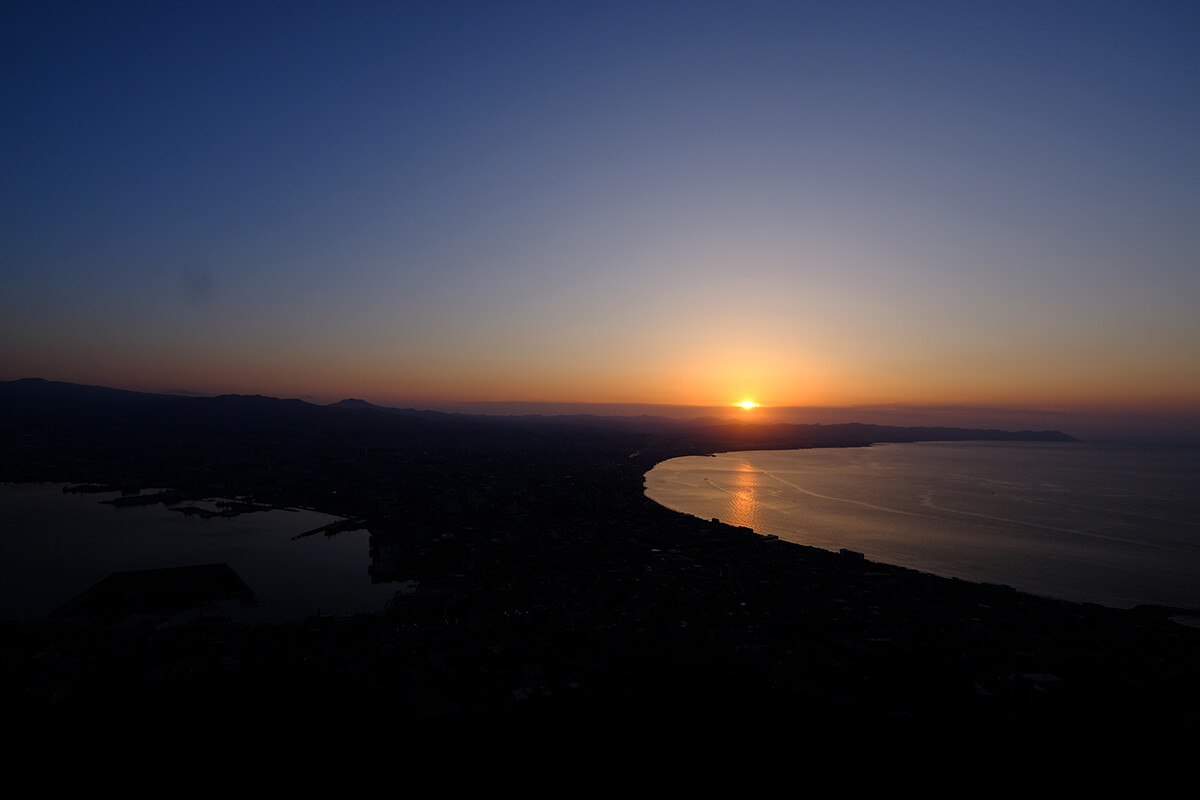
ZEISS Touit 2.8/12 / FUJIFILM X-T2 / Equivalent to 18mm / Aperture priority AE (F5.6, 1/750sec) / ISO 200 / Exposure compensation: -1.3EV / WB: Sunny / Film Simulation: Velvia / Tripod: SLIK Light Carbon E84 II
This is the sunrise view over Mt. Hakodate. It gives a majestic view of the morning glow, but from the photographs it looks more picturesque before dawn. It is recommended to leave before dawn to arrive at the site.
Many people probably thought that since the Hakodate mountain trails are traffic-regulated during night view times, private cars or rental cars would not be able to go to the summit observation deck. I spent some time in Hakodate during my kindergarten, elementary school, and junior high school days, and my mother still lives in Hakodate, but until recently I didn't know that there was a free climb during night view times. I think there are surprisingly many local people who don't know about it.
If you visit Hakodate during the free period, please make sure to take advantage of it. I also posted a photo, but it's highly recommended during the morning glow, which can be considered a secret menu at Mt. Hakodate. Except during the winter when the trail is closed, you can enjoy climbing the summit of Mt. Hakodate for free at any time, so be sure to give it a try.
Also, this time I visited Mt. Hakodate with the impression of "ZEISS Touit 2.8/12", but the compact, lightweight wide-angle lens, weighing only 270g, is perfect for travel and other purposes. Although this was not mentioned in the example from the summit of Mt. Hakodate, thanks to the ventilator blades with a 10-blade design, the ZEISS Touit 2.8/12 has a beautiful, blurred shape. When you think of a prime lens with a focal length of 18mm and an open aperture of F2.8, many people may find its numerical specs somewhat plain, but in a sense this can be said to be a characteristic of Zeiss. When you actually use it, you will see that its delicate and detailed depictions are captivated by many photography lovers.
The scenery from the summit, night views and morning glows are relatively common for photographs not only for travel, but also for mountain climbing and outdoor activities, but with a high-performance wide-angle lens like the ZEISS Touit 2.8/12, you can record your memories more beautifully. It's also a reasonable price for a Zeiss, so if you're a user of the FUJIFILM X-mount or Sony E-mount, why not consider it?
Details and purchase of "ZEISS Touit 2.8/12"
For more information about the product, please visit the official Kenko Tokinar website
Saito Titoce
 Former monthly camera magazine editor. While pursuing the spectacular views of Hokkaido and the wildlife, I was completely hooked on the outdoor life of camper vans and sleeping in my car. While traveling the entire country with his 2-year-old son and wife, he is a photographer writer who photographs and writes everything he has experienced, not only cameras and lenses, but also outdoor camping, child-rearing, PC gadgets, cooking, and dieting. OUTDOOR GEARZINE plans to write a variety of articles, focusing on the QOCL (Quality of Camping Life) Improvement Committee, which will improve the quality of life in camping and camper vans.
Former monthly camera magazine editor. While pursuing the spectacular views of Hokkaido and the wildlife, I was completely hooked on the outdoor life of camper vans and sleeping in my car. While traveling the entire country with his 2-year-old son and wife, he is a photographer writer who photographs and writes everything he has experienced, not only cameras and lenses, but also outdoor camping, child-rearing, PC gadgets, cooking, and dieting. OUTDOOR GEARZINE plans to write a variety of articles, focusing on the QOCL (Quality of Camping Life) Improvement Committee, which will improve the quality of life in camping and camper vans.



 [High performance, lightweight, compact, and bright! 】5 reasons why "ZEISS Touit 1.8/32" is a high-end standard prime focus recommended for outdoor travel
[High performance, lightweight, compact, and bright! 】5 reasons why "ZEISS Touit 1.8/32" is a high-end standard prime focus recommended for outdoor travel [Makes walking around the forest trip three times more fun! 】Why the ZEISS Touit 2.8/50M is highly efficient for both macro and portrait photography, making it a great way to explore
[Makes walking around the forest trip three times more fun! 】Why the ZEISS Touit 2.8/50M is highly efficient for both macro and portrait photography, making it a great way to explore [You can climb to the summit by car! 】I took a photo of the sea of clouds from the summit of Kamoi-dake, using "Tokina atx-m 11-18mm F2.8 E."
[You can climb to the summit by car! 】I took a photo of the sea of clouds from the summit of Kamoi-dake, using "Tokina atx-m 11-18mm F2.8 E." [A beautiful driving course that Hokkaido residents love! 】I took a look at the "Ororon Line" that you should remember in preparation for uneven weather conditions, with OM SYSTEM Large Three-Model Lens
[A beautiful driving course that Hokkaido residents love! 】I took a look at the "Ororon Line" that you should remember in preparation for uneven weather conditions, with OM SYSTEM Large Three-Model Lens